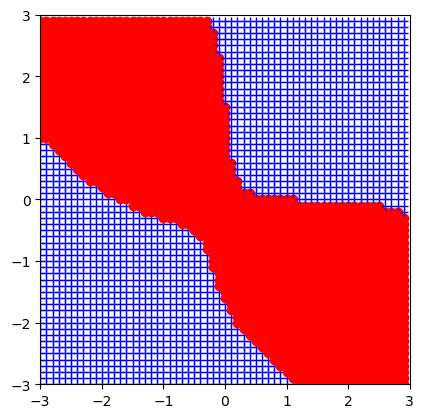Case_study_4_6#
Vanilla NN for a nonlinear classification problem.
!wget --no-cache -O init.py -q https://raw.githubusercontent.com/jdariasl/OTBD/main/content/init.py
import init; init.init(force_download=False)
import numpy as np
import matplotlib.pyplot as plt
from local.lib.utils import forward, backward
# Main parameters
mu=0.1 # Step size
Ns=500000 # Number of samples
Nh=10 # Number of neurons hidden layer
Ni=2 # Number of inputs
No=1 # Number of outputs
# Defining the input and the desired signals
x1a=np.random.randn(2,int(Ns/4))*np.sqrt(.1)+np.array([1.5,1.5]).reshape(-1,1) # Input class 1
x1b=np.random.randn(2,int(Ns/4))*np.sqrt(.1)+np.array([-1.5,-1.5]).reshape(-1,1) # Input class 1
x2a=np.random.randn(2,int(Ns/4))*np.sqrt(.1)+np.array([-1.5,1.5]).reshape(-1,1) # Input class 2
x2b=np.random.randn(2,int(Ns/4))*np.sqrt(.1)+np.array([1.5,-1.5]).reshape(-1,1) # Input class 2
# For visualization
plt.plot(x1a[0,:],x1a[1,:],marker='+',color='r',linewidth = 3)
plt.plot(x1b[0,:],x1b[1,:],marker='+',color='r',linewidth = 3)
plt.plot(x2a[0,:],x2a[1,:],marker='+',color='b',linewidth = 3)
plt.plot(x2b[0,:],x2b[1,:],marker='+',color='b',linewidth = 3)
plt.gca().set_aspect('equal')
plt.grid()
plt.show()

x=np.c_[x1a, x1b, x2a, x2b]
r=np.random.permutation(Ns)
x=x[:,r]
y=(r>(int(Ns/2))).astype(int).flatten();
# Defining the variables (weights and bias)
W1=np.zeros((Nh,Ni,Ns+1)) # Weights hidden layer
W2=np.zeros((No,Nh,Ns+1)) # Weights output layer
W1[:,:,0]=np.random.rand(Nh,Ni) # Initialization
W2[:,:,0]=np.random.rand(No,Nh) # Initialization
b1=np.zeros((Nh,Ns+1)) # Bias hidden layer
b1[:,0]=np.random.rand(Nh) # Iitialization
b2=np.zeros((No,Ns+1)); # Bias output layer
b2[:,0]=np.random.rand(No) # Initialization
tipo='logist' # Output nonlinearity
e=np.zeros(Ns) # Error signal
out=np.zeros(Ns) # Output signal
# Loop along the samples including the forward and backward steps
for k in range(Ns):
z0=x[:,k]
z1,z2,_,_=forward(W1[:,:,k],W2[:,:,k],b1[:,k],b2[:,k],z0,tipo)
e[k]=y[k]-z2
out[k]=z2
delta2, delta1=backward(W2[:,:,k],z1,z2,e[k],tipo);
W2[:,:,k+1]=W2[:,:,k]+2*mu*delta2*z1.T
b2[0,k+1]=b2[0,k]+mu*2*delta2
W1[:,:,k+1]=W1[:,:,k]+mu*2*delta1*z0;
b1[:,k+1]=b1[:,k]+mu*2*delta1.flatten();
W2_out=W2[:,:,Ns]
b2_out=b2[0,Ns]
W1_out=W1[:,:,Ns]
b1_out=b1[:,Ns]
# How to present results
x_test=np.arange(-3,3,.1)
X,Y=np.meshgrid(x_test,x_test)
out_func=np.zeros_like(X)
for k in range(len(x_test)):
for kk in range(len(x_test)):
z0=np.stack([X[k,kk],Y[k,kk]])
_, y2, _, _=forward(W1_out,W2_out,b1_out,b2_out,z0,tipo)
if y2>0.5:
plt.plot(X[k,kk],Y[k,kk],marker='o',color='r', linewidth = 3)
else:
plt.plot(X[k,kk],Y[k,kk],marker='+',color='b', linewidth = 3)
plt.axis([-3, 3, -3, 3])
plt.gca().set_aspect('equal')
plt.show()


